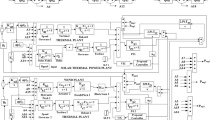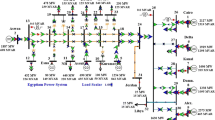Abstract
The low-frequency oscillations such as inter-area and intra-area modes of oscillations are difficult to avoid their occurrence and control in a weakly connected power system. It is essential to damp these multi-modal oscillations because these oscillations may lead to many instability issues. In this study, the application of one of the flexible AC transmission systems (FACTS) compensating device, a unified power flow controller (UPFC) is focused on its small-signal stability issues referring to inter-area and intra-area modes of operation in a multi-machine power system. Factional order Proportional Integral (FOPI) controller is applied for the control strategy against the conventional PI controller due to its flexibility and higher controllability for its extra degree of freedom to control. FOPI controller performance isn’t free from parameter dependency. An adaptive differential evolution (ADE) algorithm is suggested to optimally tune the FOPI parameters for enhancing the performance. Apart from that, the dynamic characteristics of UPFC are extensively presented through modeling in the d–q axis rotating synchronous frame of reference. To justify the feasibility and effectiveness of the proposed approach, comparative results are presented under a wide variety of disturbances in a standard multi-machine power system. It is found from the non-linear simulations that UPFC based power system is well capable to damp out these oscillations effectively to enhance the stability of small-signal disturbance substantially. The result analysis with PI and FOPI control procedures employing ADE justifies the enhanced control performance of the UPFC.










Similar content being viewed by others

Data Availability
Not applicable.
Code Availability
Not applicable.
References
Kundur P, Balu NJ, Lauby MG (2012) Power system dynamics and stability. In: Power system stability and control, vol 5
Kundur PS, Balu NJ, Lauby MG (2017) Power system dynamics and stability. In: Power system stability and control, vol 3
Zhang X-P, Rehtanz C, Pal B (2012) Flexible AC transmission systems: modeling and control. Springer, Berlin
Nayak N, Khan S, Bansfore SK (2020) Inter-area and intra-area oscillation damping for a multi-machine power system integrated with UPFC using DIW-PSO based PID controller. In: 2020 international conference on computational intelligence for smart power system and sustainable energy (CISPSSE). IEEE, pp 1–6
Zhang XP, Rehtanz C, Pal B (2012) Flexible AC transmission systems: modelling and control. Springer, Berlin
Hingorani NG (2007) FACTS technology-state of the art, current challenges and the future prospects. In: IEEE power engineering society general meeting, vol 2, p 11
Liu S, Messina AR, Vittal V (2006) A normal form analysis approach to siting power system stabilizers (PSSs) and assessing power system nonlinear behavior. IEEE Trans Power Syst 21(4):1755–1762
Messina AR (2006) Use of power system stabilizers for damping inter-area oscillations in the south systems of the Mexican electrical grid. Electr Power Syst Res 76(4):169–179
Prakash T, Singh VP, Mohanty SR (2019) A synchrophasor measurement based wide-area power system stabilizer design for inter-area oscillation damping considering variable time-delays. Int J Electr Power Energy Syst 105:131–141
Gomes S Jr, Guimarães CHC, Martins N, Taranto GN (2018) Damped Nyquist Plot for a pole placement design of power system stabilizers. Electr Power Syst Res 158:158–169
Kundur P, Berube GR, Hajagos LM, Beaulieu R (2003) Practical utility experience with and effective use of power system stabilizers. In: 2003 IEEE power engineering society general meeting (IEEE Cat. No. 03CH37491). IEEE, vol 3, pp 1777–1785
Gurrala G, Sen I (2010) Power system stabilizers design for interconnected power systems. IEEE Trans Power Syst 25(2):1042–1051
Dasu B, Sivakumar M, Srinivasarao R (2019) Interconnected multi-machine power system stabilizer design using whale optimization algorithm. Prot Control Mod Power Syst 4(1):1–11
Hussein T et al (2010) Damping inter-area modes of oscillation using an adaptive fuzzy power system stabilizer. Electr Power Syst Res 80(12):1428–1436
Vance K, Pal A, Thorp JS (2012) A robust control technique for damping inter-area oscillations. In: 2012 IEEE power and energy conference at Illinois. IEEE
Abido MA (2010) Robust design of power system stabilizers for multimachine power systems using differential evolution. In: Computational intelligence in power engineering. Springer, Berlin, pp 1–18
Ali ES (2014) Optimization of power system stabilizers using BAT search algorithm. Int J Electr Power Energy Syst 61:683–690
Jing P, Zhou F, Song J, Guo J (2013) Design and simulation of unified power flow controller based on modular multilevel converter. Power Syst Technol 37(2):356–361
Pal BC (2002) Robust damping of interarea oscillations with unified power-flow controller. IEE Proc Gener Transm Distrib 149(6):733–738
Monteiro J, Silva JF, Pinto SF, Palma J (2013) Linear and sliding-mode control design for matrix converter-based unified power flow controllers. IEEE Trans Power Electron 29(7):3357–3367
Shotorbani AM, Ajami A, Zadeh SG, Aghababa MP, Mahboubi B (2014) Robust terminal sliding mode power flow controller using unified power flow controller with adaptive observer and local measurement. IET Gener Transm Distrib 8(10):1712–1723
Chandrakar VK, Kothari AG (2008) Fuzzy logic based unified power flow controllers for improving transient stability. Int J Power Energy Syst 28(2):135
Albatsh FM, Mekhilef S, Ahmad S, Mokhlis H (2017) Fuzzy-logic-based UPFC and laboratory prototype validation for dynamic power flow control in transmission lines. IEEE Trans Industr Electron 64(12):9538–9548
Tiwari S, Naresh R, Jha R (2011) Neural network predictive control of UPFC for improving transient stability performance of power system. Appl Soft Comput. 11(8):4581–4590
Dastjerdi AA, Saikumar N, HosseinNia SH (2018) Tuning guidelines for fractional order PID controllers: rules of thumb. Mechatronics 56:26–36
Chevalier A et al (2019) Fractional-order PID design: towards transition from state-of-art to state-of-use. ISA Trans 84:178–186
Fister D et al (2016) Parameter tuning of PID controller with reactive nature-inspired algorithms. Robot Auton Syst 84:64–75
Al-Dabbagh RD et al (2018) Algorithmic design issues in adaptive differential evolution schemes: review and taxonomy. Swarm Evol Comput 43:284–311
Li Y, Wang S, Yang B (2020) An improved differential evolution algorithm with dual mutation strategies collaboration. Expert Syst Appl 153:113451
Saribulut L, Teke A, Tümay M (2011) Dynamic control of unified power flow controller under unbalanced network conditions. Simul Model Pract Theory 19(2):817–836
Kannan S, Jayaram S, Salama MMA (2004) Real and reactive power coordination for a unified power flow controller. IEEE Trans Power Syst 19(3):1454–1461
Verma SK, Yadav S, Nagar SK (2017) Optimization of fractional order PID controller using grey wolf optimizer. J Control Autom Electr Syst 28(3):314–322
Pradhan R et al (2020) Optimal fractional order PID controller design using Ant Lion Optimizer. Ain Shams Eng J 11(2):281–291
Hasanovic A (2001) A simulation and analysis toolbox for power systems and genetic algorithm-based damping controller design. West Virginia University, Morgantown
Eslami M et al (2012) An efficient particle swarm optimization technique with chaotic sequence for optimal tuning and placement of PSS in power systems. Int J Electr Power Energy Syst 43(1):1467–1478
Yu Y, Grijalva S, Thomas JJ, Xiong L, Ju P, Min Y (2015) Oscillation energy analysis of inter-area low-frequency oscillations in power systems. IEEE Trans Power Syst 31(2):1195–1203
Rogers G (2012) Power system oscillations. Springer, Berlin
Abdel-Magid YL, Abido MA, Mantaway AH (2000) Robust tuning of power system stabilizers in multimachine power systems. IEEE Trans Power Syst 15(2):735–740
Yildizdan G, Baykan ÖK (2020) A novel modified bat algorithm hybridizing by differential evolution algorithm. Expert Syst Appl 141:112949
Deng W, Shang S, Cai X, Zhao H, Song Y, Xu J (2021) An improved differential evolution algorithm and its application in optimization problem. Soft Comput 25(7):5277–5298
Funding
There is no funding.
Author information
Authors and Affiliations
Contributions
We three (Sunita S. Biswal, Dipak Ranjan Swain, and Pravat Kumar Rout) are the only authors.
Corresponding author
Ethics declarations
Conflict of Interest
I declare that there is no conflict of interest in the publication of this article, and that there is no conflict of interest with any other author or institution for the publication of this article.
Ethical Statements
I hereby declare that this manuscript is the result of our independent creation under the reviewers’ comments. Except for the quoted contents, this manuscript does not contain any research achievements that have been published or written by other individuals or groups. We are the only authors of this manuscript. The legal responsibility of this statement shall be borne by me.
Appendix 1
Appendix 1
The ith machine model as considered in the study is given as follows:
d and q denotes the direct and quadrature axis, respectively; δ and ω denotes the rotor angle and rotor speed, respectively; \(\omega_{b}\) denotes the synchronous speed; \(T_{m}\) and \(T_{e}\) denotes the input and output powers of the generator, respectively; M and D denotes the inertia constant and damping coefficient, respectively; \(E_{fd}\) denotes the field voltage; \(T_{do}^{^{\prime}}\) denotes the open circuit field time constant; \(x_{d}\) and \(x^{\prime}_{d}\) denotes the d –axis reactance and d –axis transient reactance of the generator, respectively; \(K_{a}\) and \(\tau_{a}\) denotes the gain and time constant of exciter, respectively; \(V_{ref}\) and \(V_{i}\) denotes the reference voltage and terminal voltage of exciter respectively; \(U_{i}\) denotes the input voltage of PSS, respectively; \(x_{d}\) and \(x^{\prime}_{d}\) denotes the generator’s d –axis reactance and d –axis transient reactance, respectively; \(x_{q}\) and \(x^{\prime}_{q}\) denotes the generator’s q –axis reactance and q –axis transient reactance, respectively; \(i_{d}\) and \(i_{q}\) denotes the machine's current d-axis and q-axis components, respectively;
1.1 Generator, exciter, and PSS DATA
The transfer function of the exciter and stabilizer are as follows:
\(K_{a} ,K_{e} ,K_{f} ,and_{{}} K_{g}\) denotes amplifier gains, exciter, sensor, and generator, respectively; \(\tau_{a} ,\tau_{a} ,\tau_{e} ,\tau_{f} ,and \, \tau_{g}\) denotes the amplifier time constants, exciter, sensor, and generator, respectively; \(K_{i}\) denotes gain constant of the stabilizer; \(\tau_{\omega } ,\tau_{1} ,\tau_{2} ,\tau_{3} ,and \, \tau_{4}\) denotes the time constants of stabilizer, respectively;
1.2 UPFC data
\(V_{d\_c}\) denotes the dc-link capacitor voltage; \(C_{d\_c}\) denotes the dc-link capacitor;\(X_{E}\) and \(X_{B}\) denotes the shunt converter transformer and series converter transformer, respectively; \(R_{shc}\) and \(L_{shc}\) denotes the shunt converter resistance and inductance, respectively; \(R_{\sec }\) and \(L_{\sec }\) denotes the series converter resistance and inductance, respectively;
1.3 ADE data
1.4 PSO tuned PI controller data data
1.5 ADE tuned PI controller data
1.6 ADE tuned FOPI controller data
Rights and permissions
About this article
Cite this article
Biswal, S.S., Swain, D.R. & Rout, P.K. Inter-area and intra-area oscillation damping for UPFC in a multi-machine power system based on tuned fractional PI controllers. Int. J. Dynam. Control 10, 1594–1612 (2022). https://doi.org/10.1007/s40435-021-00891-4
Received:
Revised:
Accepted:
Published:
Issue Date:
DOI: https://doi.org/10.1007/s40435-021-00891-4



